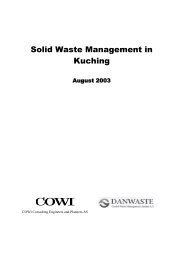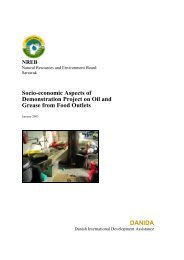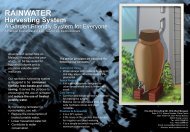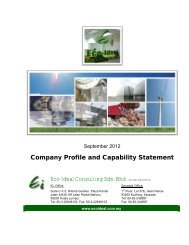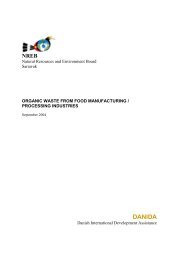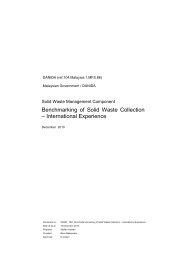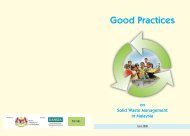source separation of food waste - turning waste into compost
source separation of food waste - turning waste into compost
source separation of food waste - turning waste into compost
You also want an ePaper? Increase the reach of your titles
YUMPU automatically turns print PDFs into web optimized ePapers that Google loves.
Project Benefits Unit Total<br />
A) Cost Savings<br />
1) Waste Tipping Fees RM45.00 X 20.8 tonnes RM935.00<br />
2) Waste Collection Costs RM1,950.00 X 6 month RM11,700.00<br />
3) Cost <strong>of</strong> Compost RM500.00 X 14.9 tonnes RM7,450.00<br />
Total<br />
RM20,085.00<br />
Indirect Benefits<br />
1) Saving <strong>of</strong> Environmental<br />
Damage cost<br />
- Contamination <strong>of</strong> Land<br />
- Leachate Treatment Cost Not Accounted<br />
Not Accounted<br />
- Human Health Risk<br />
- Greenhouse Gases Emission<br />
2) Creation <strong>of</strong> Awareness<br />
- Among the Hawkers<br />
Not Accounted<br />
Not Accounted<br />
Note: a) The <strong>waste</strong> collection fee is assumed to be 50% more as compared to the collection done to bring the <strong>waste</strong> to the<br />
<strong>compost</strong>ing site due to the travelling distances (normal disposal to Jeram Landfill)<br />
b) The tipping fee refers to the gate fee <strong>of</strong> entering Jeram Landfill<br />
c) The cost <strong>of</strong> typical <strong>compost</strong> used here was provided by MBSJ based on current market price for <strong>compost</strong> <strong>of</strong> lower<br />
fertilising value. Thus, the actual value <strong>of</strong> the <strong>food</strong> <strong>waste</strong> derived <strong>compost</strong> is expected to be higher. The savings <strong>of</strong><br />
chemical fertiliser which is in used now is also not accounted for here.<br />
From a commercial point <strong>of</strong> view, the high capital and operating cost for the selected technically advanced in-vessel<br />
high-speed solution renders the system economically non-viable. However, the system may still require lower financial<br />
support than the alternative collection and disposal costs for traditional <strong>waste</strong> disposal, implying that the solution still may<br />
constitute an economically attractive option for the solid <strong>waste</strong> management system. The costs may further be reduced<br />
in the future. The main operating costs for the system were the electricity consumption and the transportation cost. These<br />
costs might be reduced with the improvement <strong>of</strong> energy efficiency as well as the optimisation <strong>of</strong> transportation <strong>of</strong> <strong>waste</strong>.<br />
The selected in-vessel high-speed <strong>compost</strong>ing process allows very short <strong>compost</strong>ing time and very small land<br />
requirements and is therefore, suitable for congested areas where space constraint is a major barrier. In most cases<br />
where reasonable access to space is possible, traditional <strong>compost</strong>ing techniques with less capital and operating costs<br />
would probably be applied.<br />
16



